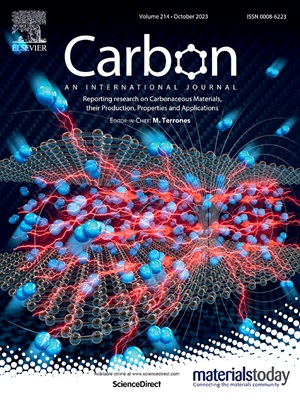Discovery of a universal mechanism for acid-modulated surfactant-based chiral separation of carbon nanotubes
IF 10.5
2区 材料科学
Q1 CHEMISTRY, PHYSICAL
引用次数: 0
Abstract
The acid modulation technique, which employs acids to facilitate the chiral separation of surfactant-dispersed single-wall carbon nanotubes (SWCNTs), is recognized as one of the most promising approaches due to its simplicity, high resolution, and efficiency. A comprehensive understanding of the underlying mechanisms is crucial for the rational optimization and further advancement of this technique. However, these mechanisms remain poorly understood, significantly hindering its advancement. Here, we elucidate the mechanisms by systematically investigating the interactions between acids and various surfactants including sodium dodecyl sulfate (SDS), sodium cholate (SC) and sodium deoxycholate (DOC), as well as between acids and SWCNTs, in conjunction with the selective adsorption of SWCNTs within the gel matrix induced by acid modulation. In single surfactant system of SDS, hydrogen ions from the acid selectively protonate SWCNTs, enhancing the attraction of the anionic surfactant SDS to their surfaces, thereby weakening their selective adsorption onto the gel matrix. In a binary surfactant system comprising bile salt surfactants (SC or DOC) and SDS, the added acids preferentially react with bile salt surfactants to form bile acid surfactants, which modulate the surfactant coating on SWCNT surfaces and drive the separation process by forming compound micelles with SDS. Based on this new understanding, we have advanced gel chromatography to achieve efficient enantiomer-level separation of multiple single-chirality SWCNTs by combining chirality-selective enrichment through acid modulation with subsequent selective desorption using a stepwise elution process. Our research establishes a significant foundation for the development of advanced surfactant-based separation techniques and future applications of SWCNTs.

基于酸调制表面活性剂的碳纳米管手性分离的通用机制的发现
酸调制技术利用酸促进表面活性剂分散的单壁碳纳米管(SWCNTs)的手性分离,因其简单、高分辨率和高效率而被认为是最有前途的方法之一。全面了解其潜在机制对于该技术的合理优化和进一步发展至关重要。然而,这些机制仍然知之甚少,严重阻碍了其发展。在这里,我们通过系统地研究酸与各种表面活性剂(包括十二烷基硫酸钠(SDS)、胆酸钠(SC)和脱氧胆酸钠(DOC))之间的相互作用,以及酸与SWCNTs之间的相互作用,以及酸调制诱导凝胶基质内SWCNTs的选择性吸附,来阐明其机制。在SDS的单表面活性剂体系中,来自酸的氢离子选择性地使SWCNTs质子化,增强阴离子表面活性剂SDS对其表面的吸引力,从而削弱其在凝胶基质上的选择性吸附。在由胆汁盐表面活性剂(SC或DOC)和SDS组成的二元表面活性剂体系中,添加的酸优先与胆汁盐表面活性剂反应形成胆汁酸表面活性剂,胆汁酸表面活性剂调节表面活性剂在swcnts表面的涂层,并通过与SDS形成复合胶束驱动分离过程。基于这一新的认识,我们开发了先进的凝胶色谱法,通过酸调制的手性选择性富集与随后使用逐步洗脱的选择性脱附相结合,实现了多个单手性SWCNTs对映体水平的高效分离。我们的研究为基于表面活性剂的先进分离技术的发展和SWCNTs的未来应用奠定了重要的基础。
本文章由计算机程序翻译,如有差异,请以英文原文为准。
求助全文
约1分钟内获得全文
求助全文
来源期刊

Carbon
工程技术-材料科学:综合
CiteScore
20.80
自引率
7.30%
发文量
0
审稿时长
23 days
期刊介绍:
The journal Carbon is an international multidisciplinary forum for communicating scientific advances in the field of carbon materials. It reports new findings related to the formation, structure, properties, behaviors, and technological applications of carbons. Carbons are a broad class of ordered or disordered solid phases composed primarily of elemental carbon, including but not limited to carbon black, carbon fibers and filaments, carbon nanotubes, diamond and diamond-like carbon, fullerenes, glassy carbon, graphite, graphene, graphene-oxide, porous carbons, pyrolytic carbon, and other sp2 and non-sp2 hybridized carbon systems. Carbon is the companion title to the open access journal Carbon Trends. Relevant application areas for carbon materials include biology and medicine, catalysis, electronic, optoelectronic, spintronic, high-frequency, and photonic devices, energy storage and conversion systems, environmental applications and water treatment, smart materials and systems, and structural and thermal applications.
 求助内容:
求助内容: 应助结果提醒方式:
应助结果提醒方式:


